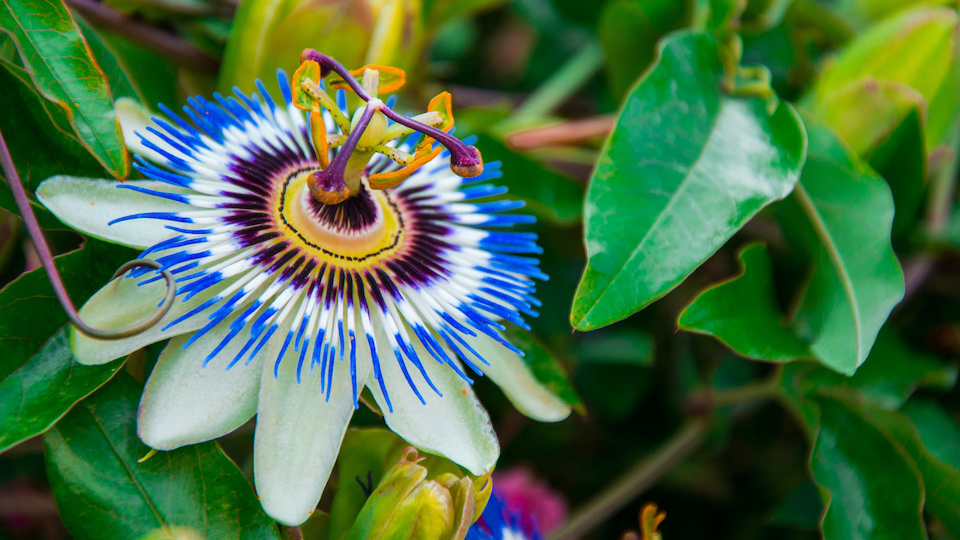Do you love exotic flowers, but think they’re either out of your gardening expertise or not likely to grow in your hardiness zone? Then you may want to consider growing a passion vine. Passion vine is a unique plant that sprouts exotic, tropical-looking flowers that can grow almost anywhere. In fact, with the genus Passiflora containing over 500 different species, you can even find these outwardly delicate vines growing alongside the road. Here’s everything you need to know about planting and caring for passion vine.
Legendary and complex blooms
Passion vine (Passiflora spp) is one of the most unique plants on the planet. The blooms from the vine are complex and the source of myths and legends. In fact, according to research, passion flowers derive their name from The Passion of Christ. Their petals and petal-like sepals are thought to represent the 10 apostles who remained faithful to Jesus. And, the circle of rays above the petals represents the crown of thorns that Jesus wore on the day of his death.
This fragrant and exotic looking genus also includes a huge selection of over 500 species divided into three main types: Yellow, purple, and granadilla (red). Actually, the vine yields quite a selection of colorful blooms that range between pale lavender and blue to flame red and orange. It has a petal base that’s wide and flat, with five or 10 petals in a flat circle. The ovary and stamens sit on top of a tall, distinctive stalk that is surrounded by delicate filaments. The stigmas grow high above the anthers and carefully bend backward to ease pollination. In fact, if you’re looking to attract butterflies and pollinators into your garden, then the passionflower is your bloom.
Common passion vine varieties:
- Passiflora caerulea produces blue flowers and grows up to 25 feet tall.
- Passiflora coccinea produces red flowers and grows 12 feet tall.
- Passiflora incarnata produces violet flowers and grows up to eight feet tall.
- Passiflora incarnata “Alba” produces white flowers and grows up to eight feet tall.
- Passiflora alata produce four-inch flowers with crimson petals and rich purple filaments.
- Passiflora edulis produces the edible passion fruit and grows and grows 10 to 15 feet tall.
Where to grow passion vine
Other names for the passion vine are Passionflower, maypop, and granadilla. These plants grow 15 feet in a season and require trimming every couple of months. Once matured, some species may grow up to 30 feet.
- Most varieties of passion vine grow as perennials in USDA hardiness zones 6 to 10. Others thrive in zones 5 and 11.
Plant in sheltered locations that have full sun to part shade. Planting against a wall is recommended for most varieties, but you can also use a trellis or even another plant. Passion vine generally needs a minimum of four full hours of sunlight a day — in cooler climates more, and partial shade in hotter climates.
Growing in containers
You can grow passion vine in containers, but you’ll need to feed and water them more often. Plus, they won’t grow quite as heartily as those growing in the ground. Use a potting soil that’s rich in nutrients. Additionally, make sure the pot has good drainage holes. Soil should be moist, but the roots should not be left soaking in water.
If brought indoors during the months, they’ll need to be kept away from drafts and in bright, indirect light. Indoor temp should be no less than about 50 degrees. Also, cut the stems down to one to two feet before moving. Keep in mind, when bringing your passion vine indoors, it will likely go semi-dormant. However, it should brighten up again in the spring.
How to plant passion vine
Most varieties of passion vine can be purchased as seedling plants. They can also be grown from either seed, cuttings, softwood, layering, or rhizomes. Typically, seedlings grow to about six to eight inches in height after about four to six weeks. They should be moved directly into the ground at that point since passion vines don’t like to be transplanted after their taproots have formed.
Passion vine requires a rich, well-draining soil. The flowers thrive best when the soil is kept moist. Adding compost to the planting hole will help retain moisture. It’s also preferable if the soil pH is in the neutral range — between 6.1 to 7.5. If you’re unfamiliar with the pH of your soil, consider doing a soil test. It’s good information to have on hand. A pH of less than seven is acidic. A pH of seven is neutral, and anything above seven is alkaline. Most plants prefer a soil pH that ranges between six and 7.5. However, some plants have specific soil requirements.
Care and feeding your passion vine
Passion vines are relatively disease and pest resistant due to naturally occurring chemical compounds. However, you can control pests like aphids and spider mites with insecticidal soap. Additionally, clean up any dropped leaves to reduce fungal diseases. Remove wilted and dead flowers to keep the plant thriving, and prune in early spring to keep aggressively growing vines at bay. Just water your plant well during the summer months to help flowers and fruit flourish. Organic mulch will help to keep the roots moist and cool.
Passion vines have that exotic look and reputation for being hard to grow — but they’re not. A little water, sunlight, and TLC will make these stunning vines a showstopper for your garden.
-Katherine Marko



